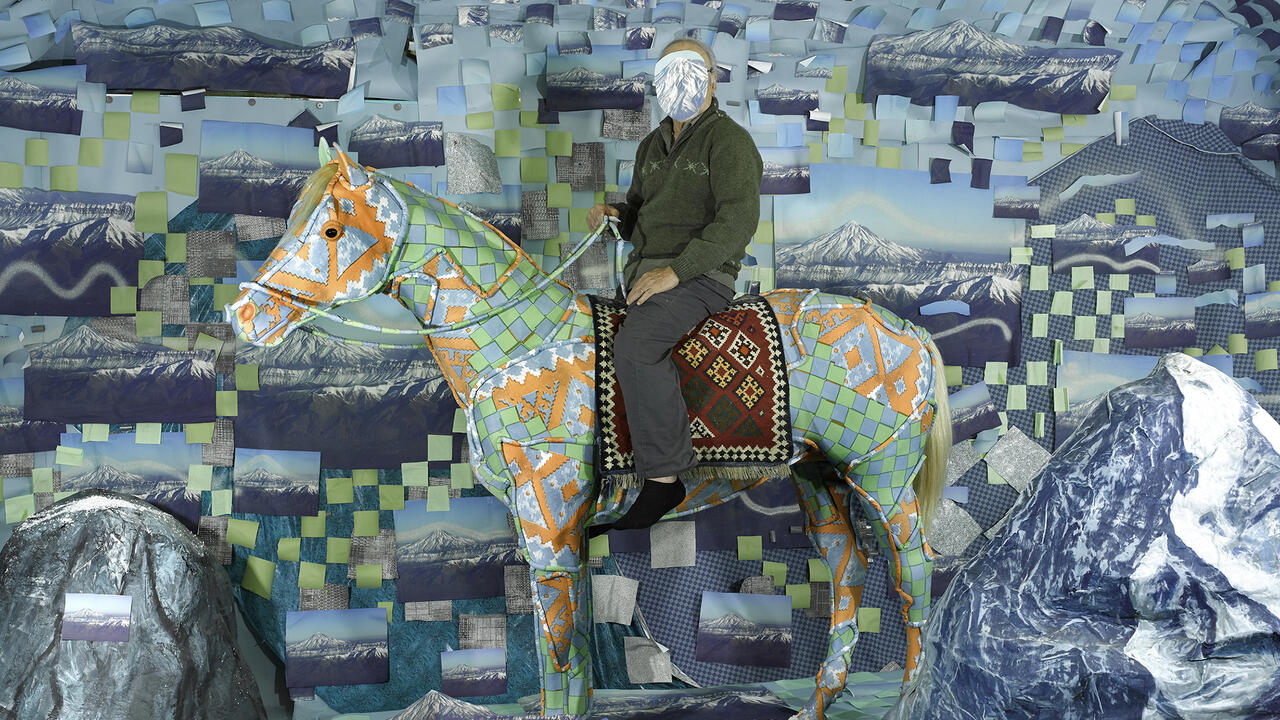Yalda Afsah Turns Her Camera on the Crowd
The artist’s latest film at Galerie Molitor, Berlin, captures a historic Spanish festival where villagers hurl vegetables at a devil
The artist’s latest film at Galerie Molitor, Berlin, captures a historic Spanish festival where villagers hurl vegetables at a devil

Every year, during the Jarramplas Festival in Piornal, Spain, more than a thousand villagers gather to throw turnips at a man in a homemade devil costume. This is no punishment; the act of embodying Satan is, in fact, a great honour bestowed on a fortunate few. ‘People can wait up to 20 years to play this role,’ explains artist Yalda Afsah, whose latest work focuses on the festival, a reenactment of a 100-year-old local legend in which residents armed with root vegetables chase away a cattle thief. Currently on view in ‘Barrage’, her first exhibition at Molitor, Berlin, the resulting film Jarramplas (2025) is the first in a new series dedicated to human rituals.

Afsah discovered the festival when in Spain making her previous film, Curro (2023). ‘I was fascinated by the fact that they are all throwing at one person,’ she tells me when I visit Molitor. Rather than focusing on the devil or el Jarramplas – whose name derives from the Spanish word arramplar meaning ‘to steal’ – the artist opted to train her camera exclusively on the movements of the turnip throwers. The crowd, often full of teenage boys, seems to relish in the violent nature of their task. ‘I’m interested in how people behave all together,’ Afsah says. ‘How do they use this setting once they’re given it?’
The artist’s interest in group dynamics can be traced back to her experience at California Institute of the Arts (CalArts) where, during an exchange year from the Berlin University of the Arts, she attended a class on ‘listening and seeing’ with legendary independent filmmaker James Benning. ‘He took us to all these crazy places in the desert, but it wasn’t about filming at all,’ she recounts. ‘The focus was the community and being in exchange with others.’
An arcane turnip-throwing festival in a tiny village becomes a metaphor for the current moment
As with Benning’s films, such as 13 Lakes (2004), Afsah’s works are ‘documentary-based’, she says, ‘without giving any proper information about a place or situation.’ There are no talking heads, for instance; instead, we see the action exactly as it appears to her from behind the lens. ‘I tried different things,’ she says, ‘but I found out that I need to be looking through the lens and reacting to what is in front of me.’ In Jarramplas, Afsah often stays in one location and allows people to come in and out of frame, a trick she learned when struggling to capture the quick movements of bulls in her 2018 film Tourneur. Although this stationary technique creates the impression of a dispassionate observer, in reality, Afsah exerts a lot of influence over the images just by tilting and panning the camera and deciding who or who not to follow with her camera.
Film has always been an important part of the artist’s life. Born in 1983 to Iranian parents, she tells me her father took her ‘to every Iranian film that played in Berlin’, inspiring an early love of cinema, eventually leading her to the works of Jim Jarmusch and the French New Wave. Unsurprisingly, Afsah’s father was very supportive of her early creative endeavours, letting her use an old Nikon that he’d lost interest in, before buying her first film camera aged 14 during a visit to a family trip to Tehran.

When it was time for her to go to university, Afsah says that studying film ‘felt too far away’. However, she took advantage of the rise of new media programmes in Germany, attending university in Halle before transferring to Berlin, where she joined the experimental film department. As well as studying with Benning at CalArts, she took classes on sound and image with director Betzy Bromberg, who she says taught her the importance of audio in filmmaking.
Sound and editing are the tools Afsah uses to build her own narrative and to ‘take the images away from the real place.’ She adds everything in post-production, trying to imagine the sounds and movements of each person caught on camera. ‘Sometimes it’s hyper-realistic, although I also like to use sound to add an irritant,’ she explains. ‘You may see someone talking but hear running water as if it’s very close.’ In Jarramplas, Afsah and her team spent a lot of energy creating a sound to correspond with the turnip throwing, which is typically a silent act unless the object is whizzing right by your ear.

The result is often as disorientating as it is mesmerizing. Shown in the darkened basement of Molitor, Jarramplas is easy to get lost in, even without knowing anything about the fascinating story behind its images. By deliberately leaving information out, Afsah avoids didacticism while still managing to make the film’s message clear. In her hands, an arcane turnip-throwing festival in a tiny village becomes a metaphor for the breakdown of social order. ‘We are in a time of violence: we see it and we are confronted with it everywhere,’ she concludes. ‘You can transport this gesture into many different situations we have in our daily lives.’
Yalda Afsah’s ‘Barrage’ is at Galerie Molitor, Berlin, until 19 April
Main image: Yalda Afsah, Jarramplas (detail), 2025, video, installation view. Courtesy: the artist and Galerie Molitor, Berlin



















